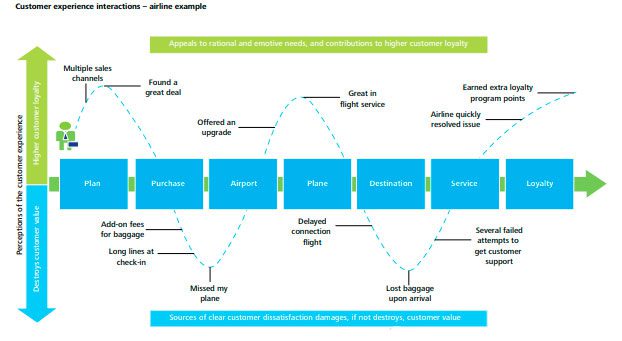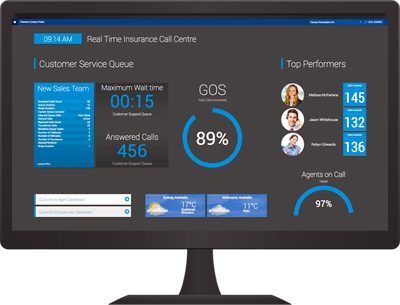There are several ways to improve profits, as any accountant will tell you.
Cost cutting is one, but it’s not the only answer. In fact, cost cutting can have a detrimental effect on profit if your service levels suffer as a result, causing your customers to go elsewhere.
Another obvious strategy for improving profits is to raise your prices or sell more. Not always easy to do in today’s very competitive and somewhat commoditised marketplace.
Improving profitability boils down to two key types of change:
1. Changing what you do to give customers what they really want, ensure they stay loyal and continue to purchase, and/or refer you, without increasing costs. That’s paramount.
2. Reducing costs or increasing margin, without affecting the status in step 1.
Here’s 9 ways any organisation can improve profitability in the contact centre.
1. Make customer experience your competitive differentiator
If you offer similar products and services, pricing and technology, how can your prospects and customers differentiate you from your competitors?
Alex Allwood, author of Customer Experience Is the Brand, argues that customer experience has become the key competitive differentiator, and is more crucial than pricing or technology.
As Allwood told The Guardian, “There is often little differentiation between one brand and the next, and so the question is what is going to be your point of difference?”
“The answer is how your customer experiences your brand,” Allwood said.
It’s how your brand makes a customer feel which will attract them, keep them loyal, or drive them away.
2. Seriously commit to becoming customer-centric
Becoming customer-centric can make a big difference to sales and profits. Research by Deloitte and Touche found that customer-centric companies were 60% more profitable compared to companies that were not focused on the customer.
However, it involves more than training your customer service teams to be more helpful or effective.
It has to be an organisation-wide focus. Having clear commitment and leadership from the top helps articulate what customer-centricity means to the organisation, and what it looks like in practice for every team member, including non-frontline staff.
Many organisations are creating new roles (eg: Customer Experience Manager) to help with implementation. Their job is to “represent the customer” and educate business functions – such as IT, HR and Operations – about the impact that policies, planned changes or behaviours can have on the customer.
Deloitte provides a good example of how departments can work together to improve the Customer Experience delivered. “Within HR, simple things like creating the flexibility to allow contact centre colleagues to ‘bank’ time that they spend working after their shift has ended to resolve a customer enquiry, can make a big difference to morale and focus on the customer.”
3. Map the customer journey and fix the CX problems
Designing and implementing a seamless and satisfactory Customer Experience across your entire organisation is to forget about departmental silos, and to think like a customer. Start by mapping typical customer journeys across all physical and digital channels.

Identify areas which can cause customer dissatisfaction and focus on resolving, or minimising permanent customer relationship damage. This often means implementing “what if” customer rescue procedures involving other functional areas.
See Why Contact Centre CX is Crucial to the Customer Journey for more examples of customer journeys and tips for mapping the journey.
4. Give customers easy-to-use self-service tools
These days most customers want the option to be able to take care of routine and straightforward interactions themselves, and only seek help for more complex enquiries.
Offering really efficient self-service shows you are committed to making customer service easier and faster.
There are many ways you can deliver self-service – including IVR, mobile customer experience, website knowledge base, automated emails, webchat or AI.
5. Give staff the tools to handle calls more efficiently
When your customers need more than self-service, your customer service staff become your front-line troops. It’s up to them to deliver your new competitive differentiator – customer experience.
If they’re not given the right tools, they will struggle to deliver a good customer experience, and profitability goes down the drain, along with team morale and customer satisfaction.
Premier Contact Point – our cloud solution for all sized contact centres – includes a range of innovative features that ensure support staff can do their jobs effectively. For example:
- The intuitive user interface is simple to use and quick to learn; agents can be comfortably up and running after just 30 minutes of training.
- Our voice biometrics module saves the team member time as they won’t need to ask who’s calling, and verify them. For example: the average time to verify the identity of a user using Personal Verifiable Questions (PVQs) is 45-90 seconds. With voice biometrics technology, it takes approximately 5-10 seconds.
- Through CRM and ERP integration, our solution lets the team member know who the customer is and potentially why they’re calling, so they’re prepared before they answer the call. This serves to reduce Average Handling Time (AHT), as well as significantly improve Customer Experience.
- We can integrate our solution with your backend office systems so the agent can see all the customer information, product information, and knowledge base in the one window.
6. Give your team leaders tools to efficiently manage staffing and demand
Your team leaders also need the right tools to be effective and take the right actions to maintain the balance between customer service levels, team member productivity and achievement of KPIs.
The Premier Contact Point dashboards provide queue overviews for instant oversight of key metrics, across a number of inbound and outbound queues. Team leaders have all the information they need to make quick and insightful decisions to improve service levels and efficiency.
Profitability is also affected by team productivity, and staffing levels during peaks and troughs. Understaffing increases customer attrition, while over-staffing increases costs.
Accurately forecasting demand and efficient scheduling of your work force is critical for improving profitability.
Implementing a workforce management solution is a fundamental way to start improving your contact centre’s performance, starting with keeping your team happy and productive.
- Forecast your requirements – you can forecast call volumes, handle times, and skills required, to roster the right mix of staff at the right time. No longer will you have to worry about having too many staff members rostered during the quiet periods, or too few staff when it’s busy, which will impact call waiting times.
- Preferred shifts – you can allow your team members to bid for their preferred shift times, or request trades with their colleagues, which leads to a more engaged and happy team. A happy team is a productive one.
- Roster adherence – you can easily monitor how well your team is adhering to their schedules, allowing you to identify areas of improvement, and maximise their productive time.
7. Give your management tools to measure performance and facilitate planning
Knowledge is power, as the old adage goes. Your management team needs reports that show datasets in a way that is aligned with your organisational operations and requirements. The reports need to be easily configurable, and combine with other reports to give the true picture of performance. Profitability cannot be accurately assessed without all the relevant data.
Our Business Insight reports have the flexibility to be combined with external data sources – like CRM datasets – to quickly build highly informative reports that display useful data in countless combinations.
For example, contact centre metrics could be combined with sales data and CRM data, to provide insights into product popularity, best time of day for purchase, buyer demographics, method of contact (call, email, chat, etc) and a host of valuable insights to facilitate future campaign and resource planning.
8. Ensure your contact centre is integral, not a silo
To truly deliver the ultimate customer experience, your frontline staff – ie: your customer support team – need to be closely linked with sales, marketing, operations, and nearly every other department.
Here’s what can happen if they’re not included in planning and decision-making, or given the recognition and support they need. It will ultimately affect service levels, productivity, morale, and profitability.
- If they don’t have easy access to the latest information (products, delivery, policies, knowledge base, etc) they will spend too much time looking for it, or provide the wrong answers to callers.
- If they’re not given the opportunity to share customer feedback and contribute to planning meetings, then other departments could be making decisions which cause customer issues, or adversely affect customer service operations.
- If there is a process in place to provide feedback, but they never hear the outcome, they’ll stop giving it, which can lead to disengagement and low morale.
9. Learn from your customers
Measuring customer satisfaction is one way to get feedback on how your Customer Experience initiatives are being received.
In our article 3 Ways to Measure Customer Satisfaction in a Contact Centre we outline the benefits and limitations of these three measurement systems:
- Customer Satisfaction Score (CSAT)
- Net Promoter Score (NPS)
- Customer Effort Score (CES)
The problem with these automated systems is that there’s no ability to get feedback outside of the multiple-choice options.
For deeper insights, consider actively involving your customers in your Customer Experience makeover journey. You could design a short survey and phone a sample of customers (ideally from different demographics) and record their feedback, or invite them to attend a focus group.
You could also monitor social media for mentions of your brand, to get a ‘fly on the wall’ view of what customers are saying about their interactions with you. (You really should be doing this anyway, as you may be receiving negative commentary, and not responding will damage your brand further.)
Treat all customer feedback as helpful, and where warranted, adjust your processes. Most importantly, let customers know that you’ve taken action as a result of their feedback. Imagine how that will make them feel!
Commit, improve, monitor and reap
It costs six or seven times more to gain a new customer than it does to keep an existing one, and loyal customers spend more and refer you to others. Customer lifetime value is an important KPI and profit metric.
A customer’s loyalty is earned through the quality of their total experience with you, not just price. If your focus is just on price, they will quickly defect to a better deal when it comes along. Show customers how much you appreciate them by delivering outstanding personalised service at every touch point.
You’ll definitely see the reward in your bottom line.
Improving Customer Experience Is Our Specialty
Delivering outstanding customer experience consistently starts with choosing the right technology. When we deploy Premier Contact Point into your customer support area, we work closely with you to develop strategies, integrations and workflows to help you achieve your CX objectives and improve your profitability.
